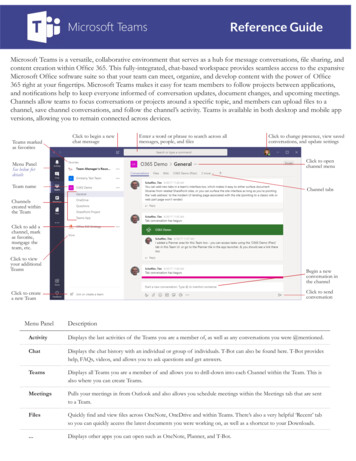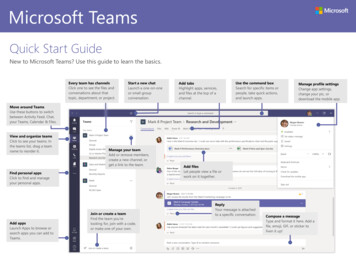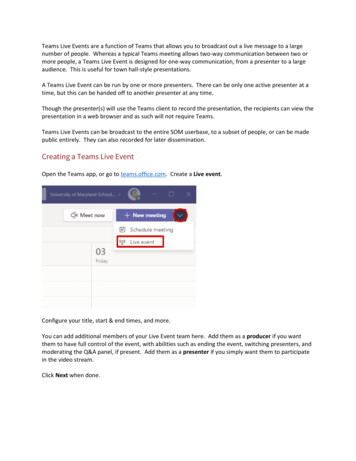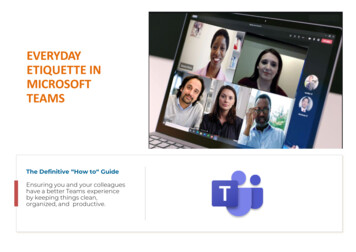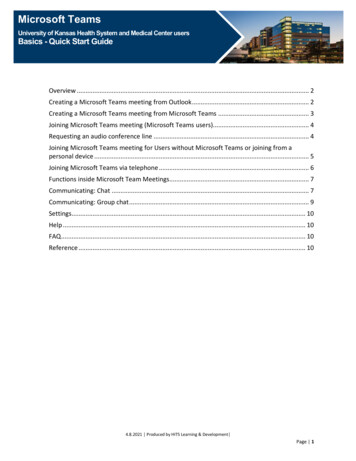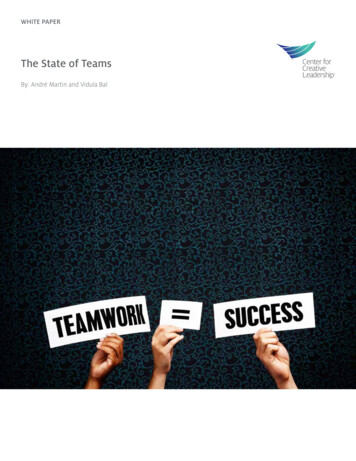
Transcription
WHITE PAPERThe State of TeamsBy: André Martin and Vidula Bal
ContentsExecutive Summary1Who Took Part in the Survey?2What are the Trends in Teams?3What do Teams Look Like Today?4What Skills do Team Leaders Need?5What are Major Team Outcomes?6What are Major Team Obstacles?7What are Potential Teams Programs?8What does the Literature Say About Teams?8Acknowledgments10About the Authors10
Executive SummaryBackgroundTeam Leaders Must Be MultitalentedAs the concept of teams has evolved, it has enteredour society with the implicit assumption that wewill enjoy increased knowledge acquisition, deepercommitment, higher performance, and greaterinnovation with increasingly less need for formalleadership (Katzenback and Smith, 1993). Though fewwill argue against this assumption, the complexitiesof the group dynamic and the puzzle of how to ensurehigh performance remain a constant struggle forresearchers and practitioners alike.Team leaders are expected to be strong communicatorsand diplomats who also have project managementskills such as organization, decision-making, andprioritization. Additionally, personal attributes—such asintellectual ability, flexibility, and courage—contributeto the profile of an effective team leader.In the age of lean organizations, one could assertthat most work groups in existence today arebeing pushed to evolve (formally and informally)toward a team philosophy as the span of control ofmanagement widens and pressures to outperformcompetition increase. To better understand the stateof teams in today’s organizations, CCL has begunresearching this area. The fundamental questionguiding this research is: “What role will teams play inorganizations of the future?”CCL’s State of Teams report provides a broad look atthe challenges, needs, and functioning of teams intoday’s organizations. This report was based on surveyresults from 118 CCL program alumni.Teams Are Central to SuccessThe results point to some interesting trends in howorganizations are using teams today. First, teamsseem to be alive and well within organizationsand play a valuable role in organizational success.Secondly, teams are being used as much to drivechange as for direct business results. As teamsare created for the design and implementationof organizational change, their design seems tonecessitate multiple team memberships, geographicaldispersion, and collaboration with other teams.1 2015 Center for Creative Leadership. All rights reserved.Collaboration is KeyThe results suggest that collaboration across teams isa significant determinant of success. The challenge fortoday’s leaders lies in the difficulty of collaborating withglobal virtual teams that often share members.Teams Are Functioning Below theOptimal LevelIn regard to the team’s internal functioning,respondents believe that most teams are notfunctioning at their optimal level, raising the questionof whether greater investment in team and team leaderdevelopment could help realize their potential. Areasof particular concern in internal functioning are thecoordination of activities, revolving team memberships,and ineffective conflict resolution.Team Coaching and CollaborationAre Areas of DevelopmentThis survey also captures market data on the currentand future programming needs of team leaders. Theserespondents are most interested in programs focusingon team coaching, team membership, and collaborationacross teams.It is obvious from this data that teams willcontinue to be an important part of organizationaleffectiveness, though team structure and purposemay continue to change. These results providea springboard to further research that can delvedeeper into the issues and trends.
Who Took Part in the Survey?Over a six-month period, 118 respondents completed an internet survey with items focused on theirknowledge and experience with teams. The statistics in this section are frequency percentagesunless otherwise noted.Participant ProfilesThe 118 respondents were alumni of two CCL programs—Leadership & High-Performance Teams(n 39) and Developing the Strategic Leader (n 79). Leadership & High-Performance Teams attractsparticipants who lead cross-functional work teams or who coach/consult to work teams. TheDeveloping the Strategic Leader program targets individuals who have the opportunity to influencestrategy in their organizations and, as a result, lead or are part of high-level, cross-functional teams.Table 2 provides demographic data describing these participants.Organizational LevelApproximately 80% of respondents described themselves as executives and upper middlemanagers, while about 6% represented the professional level. These results are not surprisingconsidering respondents are alumni of leadership development programs geared toward leaderswho are at or above middle level management.Table 1Organization LevelPercentageExecutive47%Upper Middle32%Middle15%Professional6%Years of Team ExperienceIn this category, 47% of program alumni surveyed had between six and 15 years of experienceworking with or leading teams. This finding is consistent with the senior level of respondents.Table 2Teams Experience (Years)Percentage0 to 517%6 t0 1024%11 to 1523%16 to 2017%21 to 2511%26 8% 2015 Center for Creative Leadership. All rights reserved.2
Who Took Part in the Survey? (con’t)IndustryWhen we examined the respondents’ industries, we found that 18% of respondents come fromthe healthcare/pharmaceutical sector, 17% from financial, and 15% from consumer goods. Table 3provides results from additional categories.Table inancial17%Consumer es4%Transportation3%What Are the Trends in Teams?Teams experts and consultants constantly theorize about current trends of work teams inorganizations today. Table 4 indicates the percentage of respondents who agree with eachstatement. Agreement was determined by a response of 4 or 5 on a 5-point scale.Table 4 reveals that respondents believed teams are not part of the past, but rather are alive andwell within organizations. Teams are extremely important and are heavily relied on in today’sbusiness environment.Table 43Team Trends% AgreePeople participate on more than one team at a time.95%Teams are central to organizational success.91%Our team collaborating with other teams is essential for success.87%Team members are geographically dispersed.65%Team “sponsors” are in place to enhance team performance.51%We have more informal collaboration than we do formal teams.45%Teams are short-lived (together less than one year).37%Teams are on the decline.11% 2015 Center for Creative Leadership. All rights reserved.
What Are the Trends in Teams? (con’t)Team LifespanOne claim of contemporary teams experts is thatteams are no longer together for long periods oftime but, rather, change membership or disbandfrequently. Our data do not support this claim andsuggest that teams are, in fact, remaining togetherfor at least one year.Team Leadership ChallengesFew would disagree that leading teams is a formidablechallenge. The data suggested three variables thatmay prove most challenging for today’s team leaders.First, more than 90% of respondents reported servingon more than one team at a time. In addition to theobvious resource challenges, these findings suggestteam leaders are dealing with the challenges ofmultiple team memberships and may be saddled withmembers who cannot fully commit to a task.Secondly, approximately two-thirds of respondentsreported that team members are geographicallydispersed, which could lead to challenges ofcoordination and communication.Lastly, roughly half of program alumni believedsponsors are in place to guide team success.This is potentially a challenge for team leadersbecause they may be asked to navigate theirorganization without advocates.Interteam CollaborationTeams do not operate in a vacuum; they existin the context of other teams. Therefore, onemight assert that collaboration across teams isa significant determinant of success—a theorysupported by 87% of respondents. Today’s leadersface the difficult challenge of collaborating withglobal virtual teams that often share members.This type of collaboration might be adevelopmental focus for the future.What Do Teams Look Like Today?In addition to exploring the team trends inorganizations, we were also interested in learningmore about the characteristics of today’s teams.The results indicate the percentage of respondentsin each group who agreed with the nine statementsoutlined in Table 5. Agreement was determinedby a response of 4 or 5 on a 5-point scale.In general, the results indicated there is room forimprovement across most of these characteristics.While team members tend to enjoy being partof a team and believe they have shared goals,they also see struggles with resolving conflict,coordinating activities, and constantly changingmemberships. Only about 50% of leaders believetheir team exceeds organizational expectations,leading one to ask: What are team membersmissing in performance? 2015 Center for Creative Leadership. All rights reserved.4
What Do Teams Look Like Today? (con’t)Table 5Characteristics of Teams% AgreeWe have shared goals.77%Members operate across geographic boundaries.74%We work well with other teams.70%Members enjoy being part of the team.70%We learn from our mistakes.69%We surface and resolve conflict effectively.64%Members coordinate their activites.62%Our membership stays the same for more than one year.57%The team exceeds organizational expectations.53%What Skills Do Team Leaders Need?This section contained an open-ended question that asked respondents to list the three skillsa team leader needs to be successful. The results in Table 6 represent the skill categories asdetermined through a qualitative coding and analysis process.Table 65Key Team Leader Skills% AgreeManagement Skills22%Interpersonal Skills21%Leader Attributes19%Setting Direction12%Leveraging Relationships10%Building Commitment8%Developing the Team6%Managing Conflict2% 2015 Center for Creative Leadership. All rights reserved.
What Skills Do Team Leaders Need? (con’t)Management and Interpersonal SkillsThe largest percentage fell into the category of management skills, with an emphasis on organizing,making decisions, and prioritizing work through project management. Interpersonal skills—such ascommunication, listening, and diplomacy—also appeared in the top three categories for respondents.Leader AttributesLeader attributes can be defined as the parts of an individual’s personality that cannot be easilydeveloped. Almost 19% of program alumni believe personal attributes—such as intellectual ability,courage, and flexibility—are essential to team leadership.What Are Major Team Outcomes?The purpose of this item was to gain an understanding of how organizations are using teams today.Table 7 shows the frequency percentages for the four major categories that emerged from thequalitative analysis of the responses.Table 7Key Outcome of the TeamPercentageBusiness Results36%Change30%Customer Focus22%Collaboration11%Business ResultsThe top category for program alumni was business results, which included meeting financial resultsand delivering high-quality products. These results highlight the team’s expectation for deliveringbusiness-related outcomes.Organizational ChangeApproximately 30% of respondents believed their teams were charged with change or changemanagement. Most respondents think of change as a process improvement, with cultural changeand process alignment making up only a small percentage of responses. 2015 Center for Creative Leadership. All rights reserved.6
What Are Major Team Outcomes? (con’t)These scores closely followed business results, proving just how important focusing on change anduncertainty is to organizational success. Responses in this category included process improvement(systems/structure and people), cultural change, and alignment, indicating that organizations areusing teams for broad, organizational impact work.Table 8Catergories Under Organizational ChangePercentageProcess Improvements53%General Results37%Culture5%System/Process Alignment5%What Are Major Team Obstacles?The team’s road to success is often blocked by obstacles. The following table represents thefrequencies for the top three obstacles to team success. The categories are based on CCL’s TeamEffectiveness Leadership Model (TELM).Topping the list of obstacles were organizational factors and material resources—two obstaclesthat are not within direct control of the team leader. Based on these results, organizations might berequiring teamwork without the adequate support of materials, sponsorship, and human resources.The two biggest obstacles under the team leader’s control are group dynamics and vision.This might be explained by leaders joining new teams with the belief that people issues solvethemselves and that vision is unnecessary.Table 97Obstacles to Team SuccessPercentageOrganizational Factors22%Material Resources18%Group Dynamics12%Vision/Dream6%Environmental Factors6%Interteam Dynamics1%Geographical Issues1%Interpersonal Effort1% 2015 Center for Creative Leadership. All rights reserved.
What Are Potential Teams Programs?The program offerings section asked Leadership & High-Performance Teams alumni (Developing theStrategic Leader participants were not given this portion of the survey.) to assess the extent theyagree that CCL should offer new programs focusing on a variety of teams specialty areas. Table 10shows the percent of favorable for respondents.Leadership & High-Performance Teams alumni were most interested in programs that focused onteam coaching, team membership, and collaboration across teams. These results suggest that teamleaders struggle with helping teams in crisis or who need development, working effectively withother teams, and developing high-performing team members. Leaders need help building strongteams and keeping teams on track toward exceeding expectations.Table 10Future Teams Programs% AgreesI agree that CCL should offer courses in the following areas.Team Coaching (those who consult to teams in crisis or for development)80%Team Membership (for more effective team membership)69%Team Sponsorship (aiding those who provide teams organizational support)67%Collaboration Across Teams (working with other teams more effectively)64%Teaming (those who want their “work groups” to be more collaborative)59%Innovation Teams (teams charged with creating new products/services)54%Virtual Team Leadership (leading geographically-dispersed teams)51%What Does the Literature Say About Teams?In an attempt to examine the popular perspective on teams in business, we analyzed literaturefrom several business publications over the past four and a half years, including BusinessWeek,BusinessWeek Online, Fast Company, Fortune, Harvard Business Review, Training Development (T D),and Training Magazine.We searched specifically for content on team leadership, team anecdotes, team building, virtualteams, innovation and creative teams, and team learning. Central findings from this research aredescribed on the next page. 2015 Center for Creative Leadership. All rights reserved.8
What Does the Literature Say About Teams? (con’t)Team LeadershipVirtual TeamsTeam leadership is a major focus of popular teamsliterature, with team leadership literature dominatingnearly half of the reviewed articles. Two subcategoriesof articles exist within the larger category of teamleadership—articles that focused entirely on teamleadership in general and articles that focused onproviding advice for team leaders.Virtual team articles provide a wealth of virtual teamresearch and suggestions. This is not surprising dueto recent developments in technology and businessglobalization. These articles examine navigatingteamwork when distance is a key factor and providetips on working with people from globallydiverse cultures.Team AnecdotesTeam LearningTeam anecdotes—the second largest category ofarticles—does not focus on a specific teams topic, buton the literature technique used to portray teams inaction. Many articles used anecdotes of real teamsin real situations with either positive or negativeoutcomes, instead of focusing on a particularteam topic.Only two articles were found on team learning thatemphasize the role of team learning to the overalleffectiveness of team performance. It is difficultto say whether popular publications have simplyignored the recent developments on this topic, orwhether the study of team learning has not providedany new research in the last few years. These twoin-depth articles about team learning may indicate afuture trend similar to that of innovation teams.Team BuildingTeam building articles provide a large majority of thecontent within the teams literature. Focusing mostlyon individual development, personality exploration,and basic team member familiarization techniques, theteam building articles provide an array of suggestionsfor creating more team synergy. Suggestions includeusing visual aids, bonding with team members, andfostering a climate of dialogue by asking feedbackon shared ideas.9 2015 Center for Creative Leadership. All rights reserved.
AckowledgementsWe would like to acknowledge the following people fortheir support and effort on behalf of this project:David Altman for sponsoring this research project.Dennis Lindoerfer for assistance in coding and analyzingdata and proofing drafts.Phil Willburn for his SPSS analysis, data interpretation,and literature review.Jessica Baltes for analyzing and interpreting data fromDeveloping the Strategic Leader participants.About the AuthorsAndré Martin, a former enterprise associate with theCenter for Creative Leadership, is currently the LeadershipDevelopment director for Mars, Inc. André holds amaster’s degree and PhD in organizational psychologyfrom St. Louis University.Vidula Bal is a group manager of open-enrollmentprograms in Colorado Springs. In addition to facilitating avariety of leadership programs (including the LeadershipDevelopment Program (LDP) , the Looking GlassExperience, and Leadership and High-PerformanceTeams), she is the acting global manager of the LDP, theCenter’s flagship offering. Her research has been publishedin several venues including the Encyclopedia of Television,Personnel Psychology, and Leadership in Action.To learn more about this topic or the Center forCreative Leadership’s programs and products,please contact our Client Services team. 1 800 780 1031 1 336 545 2810info@ccl.org 2015 Center for Creative Leadership. All rights reserved.10
The Center for Creative Leadership (CCL ) is a top-ranked,global provider of leadership development. By leveragingthe power of leadership to drive results that matter mostto clients, CCL transforms individual leaders, teams,organizations and society. Our array of cutting-edgesolutions is steeped in extensive research and experiencegained from working with hundreds of thousands ofleaders at all levels. Ranked among the world’s Top 5providers of executive education by the Financial Timesand in the Top 10 by Bloomberg Businessweek, CCL hasoffices in Greensboro, NC; Colorado Springs, CO;San Diego, CA; Brussels, Belgium; Moscow, Russia;Addis Ababa, Ethiopia; Johannesburg, South Africa;Singapore; Gurgaon, India; and Shanghai, China.CCL - Americaswww.ccl.org 1 800 780 1031 (U.S. or Canada) 1 336 545 2810 (Worldwide)info@ccl.orgGreensboro, North Carolina 1 336 545 2810Colorado Springs, Colorado 1 719 633 3891San Diego, California 1 858 638 8000CCL - Europe, Middle East, Africawww.ccl.org/emeaCCL - Asia Pacificwww.ccl.org/apacBrussels, Belgium 32 (0) 2 679 09 10ccl.emea@ccl.orgSingapore 65 6854 6000ccl.apac@ccl.orgAddis Ababa, Ethiopia 251 118 957086LBB.Africa@ccl.orgGurgaon, India 91 124 676 9200cclindia@ccl.orgJohannesburg, South Africa 27 (11) 783 4963southafrica.office@ccl.orgShanghai, China 86 21 6881 6683ccl.china@ccl.orgMoscow, Russia 7 495 662 31 39ccl.cis@ccl.orgAffiliate Locations: Seattle, Washington Seoul, Korea College Park, Maryland Ottawa, Ontario, CanadaFt. Belvoir, Virginia Kettering, Ohio Huntsville, Alabama San Diego, California St. Petersburg, FloridaPeoria, Illinois Omaha, Nebraska Minato-ku, Tokyo, Japan Mt. Eliza, Victoria, AustraliaCenter for Creative Leadership, CCL and its logo are trademarks owned by the Center for Creative Leadership. 2015 Center for Creative Leadership. All rights reserved.Issued 2007/Reprinted October 2015
Our team collaborating with other teams is essential for success. 87% Team members are geographically dispersed. 65% Team “sponsors” are in place to enhance team performance. 51% We have more informal collaboration than we do formal teams. 45% Teams are short-lived (together less than one year). 37
